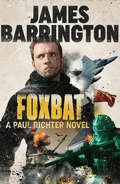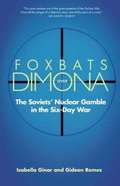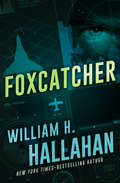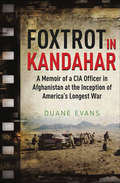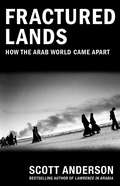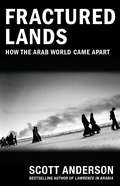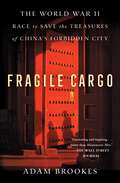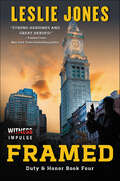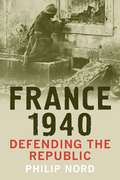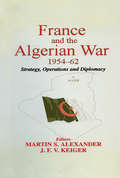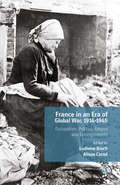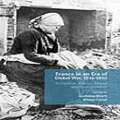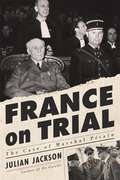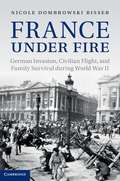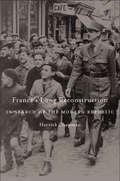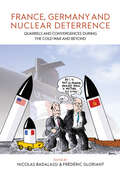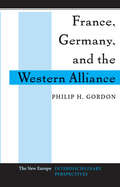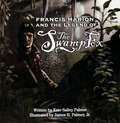- Table View
- List View
Foxbat (An Agent Paul Richter Thriller)
by James BarringtonStop the nuclear strike – at all costs…1976: A Russian pilot defects to Japan in a MiG-25 Foxbat interceptor, but is prematurely captured by the Americans. Before the aircraft is handed back to the Russians, it is reduced to a pile of components and then rebuilt. Despite the wealth of intelligence the Americans glean, however, they fail to realise its true purpose…The present day:American satellites have detected unusual activity at several Algerian air bases. At Aïn Oussera, a large hangar has been cordoned off and armed guards are posted outside. Western intelligence agencies suspect that Algeria might be launching an attack on Libya or Morocco. But they also have a greater concern: that these new weapons systems could be targeted by a rogue nuclear state. With global security in the balance, the only way to find the true threat is to get someone inside.Paul Richter is this ‘deniable asset’, called into action once more in a furiously exciting thriller, perfect for fans of Tom Clancy, Robert Ludlum or Mark Greaney.
Foxbats over Dimona: The Soviets' Nuclear Gamble in the Six-Day War
by Isabella Ginor Gideon RemezThe authors' groundbreaking history of the Six-Day War in 1967 radically changes our understanding of that conflict, casting it as a crucial arena of Cold War intrigue that has shaped the Middle East to this day.
Foxcatcher
by William H. HallahanFormer CIA agent Charlie Brewer finds himself the bait in a trap set by the United States and Iran. “Best thriller I’ve read in years” (The Washington Post). Meet Robert McCall, a man sinking deep into the seamy underside of intelligence work, into activities he knows are both illegal and immoral. Now McCall sees a chance to redeem himself by thwarting a daring plot to smuggle America’s most lethal high-tech war material to Iran. It’s a chance he’s ready to kill for. The likely victim: Charlie Brewer, a brilliant, embittered former intelligence operative who is desperate for answers. He was framed for an illegal arms deal and doesn’t know why; he’s been released from prison and doesn’t know why; he thinks he’s been marked for murder and doesn’t know why. When Brewer is approached by Iran’s most ruthless secret agent, he realizes treason may be the price of survival. “Up there with The Day of the Jackal for consistently sustained excitement.” —Gregory McDonald “The pace is smoothly breakneck, the plot wonderfully intricate and clear, the characters richly diverse. The pleasure of this satisfying thriller is increased by its effective humor and some delicious twists at the end.” —Publishers Weekly
Foxtrot in Kandahar: A Memoir of a CIA Officer in Afghanistan at the Inception of America's Longest War
by Duane EvansA thrilling true story of courage and duty after 9/11—“an extraordinary read from cover to cover . . . Gritty, frustrating, brutal, exhilarating” (Midwest Book Review). Within hours after the World Trade Center attacks in 2001, ex-Green Beret Duane Evans began a personal quest to become part of the US response against al-Qa’ida. His determination led him to join one of the CIAs elite teams bound for Afghanistan. It was a journey that eventually took him to the front lines in Pakistan—first as part of the advanced element of a CIA group supporting President Hamid Karzai, and finally as leader of the under-resourced and often overlooked Foxtrot team. Evans’s mission was to venture into southern Afghanistan, where the Taliban and al-Qa’ida held sway, and try to organize a cohesive resistance among the fractious warlords and tribal leaders. He traveled in the company of Pashtun warriors—one of only a handful of Americans pushing forward across the desert into some of the most dangerous, yet mesmerizingly beautiful, landscape on earth. Brilliantly crafted and fast-paced, Foxtrot in Kandahar “dramatically reports the huge challenges and exceptional success of [Evans’s] and his brothers’ work in Afghanistan defeating the Taliban and Al-Qaeda in nine weeks” (Ambassador Cofer Black, former director, Counterterrorist Center, CIA).
Fractured Lands: How the Arab World Came Apart
by Scott AndersonThe catastrophic story of how the Arab world has descended into chaos since the 2003 invasion of Iraq as told by the National Book Critics Circle Award finalist and international bestselling author of Lawrence in Arabia, a probing and insightful work of reportage.From world-renowned war correspondent, Scott Anderson, comes this gripping, human account of the unraveling of the Arab world, the rise of ISIS, and the global refugee crisis after the United States invasion of Iraq in 2003. Thisportrait of the region is framed by the stories of six individuals--the matriarch of a dissident Egyptian family, a Libyan Air Force cadet with divided loyalties, an Iraqi day-laborer turned ISIS fighter, a Kurdish doctor on leave from his practice to fight ISIS, a college student caught in the chaos of Aleppo, and an Iraqi women's rightsactivist targeted by militias. Through these personal stories, the myriad, complex causes of the widespread war and instability in the region come into focus and the concrete reality of the unspeakable tragedies occurring in the Middle East becomes clear.
Fractured Lands: How the Arab World Came Apart
by Scott AndersonFrom the bestselling author of Lawrence in Arabia, a piercing account of how the contemporary Arab world came to be riven by catastrophe since the 2003 United States invasion of Iraq.In 2011, a series of anti-government uprisings shook the Middle East and North Africa in what would become known as the Arab Spring. Few could predict that these convulsions, initially hailed in the West as a triumph of democracy, would give way to brutal civil war, the terrors of the Islamic State, and a global refugee crisis. But, as New York Times bestselling author Scott Anderson shows, the seeds of catastrophe had been sown long before. In this gripping account, Anderson examines the myriad complex causes of the region’s profound unraveling, tracing the ideological conflicts of the present to their origins in the United States invasion of Iraq in 2003 and beyond. From this investigation emerges a rare view into a land in upheaval through the eyes of six individuals—the matriarch of a dissident Egyptian family; a Libyan Air Force cadet with divided loyalties; a Kurdish physician from a prominent warrior clan; a Syrian university student caught in civil war; an Iraqi activist for women’s rights; and an Iraqi day laborer-turned-ISIS fighter. A probing and insightful work of reportage, Fractured Lands offers a penetrating portrait of the contemporary Arab world and brings the stunning realities of an unprecedented geopolitical tragedy into crystalline focus.
Fragile Cargo: The World War II Race to Save the Treasures of China's Forbidden City
by Adam BrookesThe gripping true story of the bold and determined museum curators who saved the priceless treasures of China&’s Forbidden City in the years leading up to World War II and beyond.Spring 1933: The silent courtyards and palaces of Peking&’s Forbidden City, for centuries the home of Chinese emperors, are tense with fear and expectation. Japan&’s aircrafts drone overhead, its troops and tanks are only hours away. All-out war between China and Japan is coming, and the curators of the Forbidden City are faced with an impossible question: how will they protect the vast imperial art collections in their charge? A difficult and monumental decision is made: to safeguard the treasures, they will need to be evacuated. The magnificent collections contain a million pieces of art—objects that carry China&’s deepest and most ancient memories. Among them are irreplaceable artefacts: exquisite paintings on silk, vanishingly rare Ming porcelain, and the extraordinary Stone Drums of Qin, which are adorned with 2,500-year-old inscriptions of crucial cultural significance. For sixteen terrifying years, under the quiet leadership of museum director Ma Heng, the curators would go on to transport the imperial art collections thousands of miles across China—up rivers of white water, across mountain ranges, and through burning cities. In their search for safety the curators and their fragile, invaluable cargo journeyed through the maelstrom of violence, chaos, and starvation that was China&’s Second World War. Told for the first time in English and playing out across a vast historical canvas, this is the exhilarating story of a small group of men and women who, when faced with war&’s onslaught on civilization, chose to resist. Fragile Cargo reminds us of the enduring power of beauty in a world beset by conflict and violence.
Fragments of Light
by Michele PhoenixAn impossible decision in the chaos of D-Day. Ripples that cascade seventy-five years into the present. And two lives transformed by the tenuous resolve to reach out of the darkness toward fragments of light. Cancer stole everything from Ceelie—her peace of mind, her self-image, perhaps even her twenty-three-year marriage to her college sweetheart, Nate. Without the support of Darlene, her quirky elderly friend, she may not have been able to endure so much loss.So when Darlene&’s prognosis turns dire, Ceelie can&’t refuse her seemingly impossible request—to find a WWII paratrooper named Cal, the father who disappeared when Darlene was an infant, leaving a lifetime of desolation in his wake.The search that begins in the farmlands of Missouri eventually leads Ceelie to a small town in Normandy, where she uncovers the harrowing tale of the hero who dropped off-target into occupied France.Alternating between Cal&’s D-Day rescue by two young French sisters and Ceelie&’s present-day journey through trial and heartbreak, Fragments of Light poses a timeless question: When life becomes unbearable, will you press toward the light or let the darkness win?Praise for Fragments of Light&“With depth of emotion and vivid images of a war-torn WWII world, Fragments of Light nails down the achingly real in a character&’s journey, tackling both raw and poignant moments from a practiced pen. Michele Phoenix shines a spotlight on God&’s chasm-crossing persistence to rebuild the shattered places of our lives—and the people He uses to do it—no matter how much time has passed between brokenness and the quest for healing. Readers will root for Ceelie and Nate long after they&’ve turned the last page!&” —Kristy Cambron, bestselling author of The Butterfly and the Violin and the Lost Castle novels&“Michèle Phoenix skillfully explores the strength and resiliency of the human spirit but also its heartbreaking limits. Brimming with expertly researched wartime details, Fragments of Light abounds with poignancy and insight.&” —Susan Meissner, bestselling author of The Last Year of the War&“Ceelie&’s anguish and hope, Darlene&’s spunk and pain, and Cal&’s courage and conviction—all of it combines to create a story as beautiful as it is heartbreaking. In short, I loved this book!&” —Lauren Denton, USA TODAY bestselling author of The Hideaway and The Summer House&“A compelling story across time of love, loss, and what happens when tragedy strikes." —Katherine Reay, bestselling author of Dear Mr. Knightley and The Printed Letter Bookshop&“An immersive and unforgettable treatise on the power of love in all of its manifestations." —Rachel McMillon, author of The London Restoration&“It&’s not often a story moves me as Fragments of Light has. With a rare and honest voice, Michèle Phoenix weaves a story of heroes from yesteryear and also those from your neighborhood—each with hearts of valor—as they endure the fight of their lives." —Elizabeth Byler Younts, Carol Award–winning author of The Solace of Water
Fram
by Steve HimmerFram is the story of Oscar, a minor bureaucrat in the US government's Bureau of Ice Prognostication, an agency created to compete with the Soviets during the heyday of the Cold War and still operating in the present without the public's knowledge. Oscar and his partner Alexi are tasked with inventing discoveries and settlements in the Arctic, then creating the paperwork and digital records to "prove" their existence, preventing the inconvenience and expense of actual exploration. The job is the closest Oscar has come to his boyhood dream of being a polar explorer, until he and Alexi are sent on a secret mission to the actual Arctic, which brings them into a mysterious tangle of rival agencies and espionage that grows more dangerous the farther north they travel. The trip also allows Oscar to reconnect with his wife, Julia, from whom he's grown alienated by years of lying about what he does for a living (a distance compounded by Julia's own secret government job), leading both of them to discover what can be lost if we let one part of ourselves--or one part of a story--distract us from everything else the world offers.Steve Himmer is the author of the novel The Bee-Loud Glade (2011) and editor of the web journal Necessary Fiction. His stories, essays, and reviews have appeared in publications including the Millions, Ploughshares, Post Road, Hobart, 3:AM Magazine, and the Los Angeles Review. He lives with his wife and daughter near Boston, Massachusetts, where he teaches at Emerson College.
Framed: A Duty & Honor Novel (Duty & Honor #4)
by Leslie JonesThe next action-packed thriller from the author of Night Hush, Bait, and Deep Cover…When former hacker turned FBI cybersecurity specialist Hadley "Lark" Larkspur is asked to analyze a piece of malware, she never imagines the simple task will put her on the radar of underworld criminals. After armed gunmen try to abduct her outside a nightclub, though, it’s suddenly clear she’s in way over her head. Delta Force operator Thomas "Mace" Beckett is in Boston awaiting his next assignment when he witnesses an attempted kidnapping. His training forces him to intervene, but then the woman pulls a gun on him. Mace isn’t sure what to make of the spitfire holding him hostage, but he quickly discovers that Lark is an innocent pawn in a dangerous game. Someone has framed her for the theft of millions from the mafia, and they want her to pay... in blood, if necessary. With only days to find the funds, Lark and Mace scramble to track the real culprit. But their investigation unexpectedly leads straight to the heart of a terrible plot, one that could mean death for thousands. The criminals have stolen something far worse than money... and it’s about to be auctioned off to the highest bidder.
Framing the Holocaust in Polish Aftermath Cinema: Posthumous Materiality and Unwanted Knowledge (Palgrave Film Studies and Philosophy)
by Matilda MrozThis book offers a unique perspective on contemporary Polish cinema’s engagement with histories of Polish violence against their Jewish neighbours during the Holocaust. Moving beyond conventional studies of historical representation on screen, the book considers how cinema reframes the unwanted knowledge of violence in its aftermaths. The book draws on Derridean hauntology, Didi-Huberman’s confrontations with art images, Levinasian ethics and anamorphosis to examine cinematic reconfigurations of histories and memories that are vulnerable to evasion and formlessness. Innovative analyses of Birthplace (Łoziński, 1992), It Looks Pretty From a Distance (Sasnal, 2011), Aftermath (Pasikowski, 2012), and Ida (Pawlikowski, 2013) explore how their rural filmic landscapes are predicated on the radical exclusion of Jewish neighbours, prompting archaeological processes of exhumation. Arguing that the distressing materiality of decomposition disturbs cinematic composition, the book examines how Poland’s aftermath cinema attempts to recompose itself through form and narrative as it faces Polish complicity in Jewish death.
France 1940
by Philip NordIn this revisionist account of France's crushing defeat in 1940, a world authority on French history argues that the nation's downfall has long been misunderstood. Philip Nord assesses France's diplomatic and military preparations for war with Germany, its conduct of the war once the fighting began, and the political consequences of defeat on the battlefield. He also tracks attitudes among French leaders once defeat seemed a likelihood, identifying who among them took advantage of the nation's misfortunes to sabotage democratic institutions and plot an authoritarian way forward. Nord finds that the longstanding view that France's collapse was due to military unpreparedeness and a decadent national character is unsupported by fact. Instead, he reveals that the Third Republic was no worse prepared and its military failings no less dramatic than those of the United States and other Allies in the early years of the war. What was unique in France was the betrayal by military and political elites who abandoned the Republic and supported the reprehensible Vichy takeover. Why then have historians and politicians ever since interpreted the defeat as a judgment on the nation as a whole? Why has the focus been on the failings of the Third Republic and not on elite betrayal? The author examines these questions in a fascinating conclusion.
France Since the Liberation: Between Exceptionalism and Convergence (Routledge Studies in the Modern History of France)
by Gino RaymondThis book focuses on the tension between the modernising thrust that places France on a trajectory of convergence with comparable liberal democracies and the defence of a national specificity that can act as a brake, complicating France’s relationship with its neighbours, its present and its past. This ambivalence in French political and social life stems from the conscious attempt to rebuild the nation after the trauma of Occupation during World War II and the new beginning provided by the Liberation. The government of the Fourth Republic embraced the pursuit of a modernisation that would enable it to regain its place among the world’s leading democratic states. However, this modernising ambition co-exists with the belief in a specific destiny and a unique sense of mission that are intrinsic to the emergence of a sense of nationhood after the revolution of 1789. Raymond defines a critical perspective that draws together historical, economic, social, and political issues into a coherent understanding of what makes France the way it is today. Written with both academic rigour and a highly accessible clarity of style, this volume is a valuable resource for students, educators, and researchers in French and European Studies.
France and the Algerian War, 1954-1962: Strategy, Operations and Diplomacy
by Martin S. Alexander J. F. V. KeigerThe French Army's war in Algeria has always aroused passions. This book does not whitewash the atrocities committed by both sides; rather it focuses on the conflict itself, a perspective assisted by the French republic's official admission in 1999 that what happened in Algeria was indeed a war.
France and the Coming of the Second World War, 1936-1939 (Routledge Revivals)
by Anthony AdamthwaiteFirst published in 1977, France and the Coming of the Second World War investigates the policies that led to the collapse of French power. The book argues that this collapse was the result of social, political, and economic troubles that buffeted French leaders. It uses a wealth of documents to explore common debates, such as Britain’s culpability for France’s inability to prevent Germany’s reoccupation of the Rhineland. It also puts forward the threat of Italy and the Mediterranean as France’s main preoccupation, rather than Germany and central Europe. France and the Coming of the Second World War uses an extensive range of archival material and includes the private papers of Daladier, Bonnet, and a number of other prominent figures. It will appeal to those with an interest in the history of the Second World War, political history, and social history.
France and the Second World War: Resistance, Occupation and Liberation
by Peter DaviesFrance and the Second World War is a concise introduction to a crucial and controversial period of French history - world war and occupation. During World War Two, France had the dramatic experience of occupation by the Germans and the legacy of this traumatic time has lived on until today, to the enduring fascination of historians and students. France and the Second World War provides a fresh and balanced insight into the events of this era of conflict, exploring the key themes of:* Occupation as a social, economic and political phenomenon* the Vichy regime and the politics of collaboration* the 'resistance', resistors and its ideology* the liberation* the legacy of the wartime period.
France in an Era of Global War, 1914-1945: Occupation, Politics, Empire and Entanglements
by A. Carrol L. BrochIn France in an Era of Global War, scholars re-examine experiences of French politics, occupation, empire and entanglements with the Anglophone world between 1914 and 1945. In doing so, they question the long-standing myths and assumptions which continue to surround this period, and offer new avenues of enquiry.
France in an Era of Global War, 1914–1945
by Ludivine BrochIn France in an Era of Global War, scholars re-examine experiences of French politics, occupation, empire and entanglements with the Anglophone world between 1914 and 1945. In doing so, they question the long-standing myths and assumptions which continue to surround this period, and offer new avenues of enquiry.
France on Trial: The Case of Marshal Pétain
by Julian JacksonFor three weeks in July 1945 all eyes were fixed on a humid Paris, where France’s disgraced former head of state was on trial, accused of masterminding a plot to overthrow democracy. Would Philippe Pétain, hero of Verdun, be condemned as the traitor of Vichy?In the terrible month of October 1940, few things were more shocking than the sight of Marshal Philippe Pétain—supremely decorated hero of the First World War, now head of the French government—shaking hands with Hitler. Pausing to look at the cameras, Pétain announced that France would henceforth collaborate with Germany. “This is my policy,” he intoned. “My ministers are responsible to me. It is I alone who will be judged by History.”Five years later, in July 1945, after a wave of violent reprisals following the liberation of Paris, Pétain was put on trial for his conduct during the war. He stood accused of treason, charged with heading a conspiracy to destroy France’s democratic government and collaborating with Nazi Germany. The defense claimed he had sacrificed his personal honor to save France and insisted he had shielded the French people from the full scope of Nazi repression. Former resisters called for the death penalty, but many identified with this conservative military hero who had promised peace with dignity.The award-winning author of a landmark biography of Charles de Gaulle, Julian Jackson uses Pétain’s three-week trial as a lens through which to examine one of history’s great moral dilemmas. Was the policy of collaboration “four years to erase from our history,” as the prosecution claimed? Or was it, as conservative politicians insist to this day, a sacrifice that placed pragmatism above moral purity? As head of the Vichy regime, Pétain became the lightning rod for collective guilt and retribution. But he has also been an icon of the nationalist right ever since. In France on Trial, Jackson blends courtroom drama, political intrigue, and brilliant narrative history to highlight the hard choices and moral compromises leaders make in times of war.
France under Fire
by Nicole Dombrowski Risser'We request an immediate favour of you, to build a shelter for us women and small children, because we have absolutely no place to take refuge and we are terrified!' This French mother's petition sent to her mayor on the eve of Germany's 1940 invasion of France reveals civilians' security concerns unleashed by the Blitzkrieg fighting tactics of World War II. Unprepared for air warfare's assault on civilian psyches, French planners were among the first in history to respond to civilian security challenges posed by aerial bombardment. France under Fire offers a social, political and military examination of the origins of the French refugee crisis of 1940, a mass displacement of eight million civilians fleeing German combatants. Scattered throughout a divided France, refugees turned to German Occupation officials and Vichy administrators for relief and repatriation. Their solutions raised questions about occupying powers' obligations to civilians and elicited new definitions of refugees' rights.
France's Long Reconstruction: In Search of the Modern Republic
by Herrick ChapmanPostwar recovery required a transformation of France, but what form it should take remained a question. Herrick Chapman charts the course of France’s reconstruction from 1944 to 1962, offering insights into the ways the expansion of state power produced fierce controversies at home and unintended consequences abroad in France’s crumbling empire.
France, Germany, and Nuclear Deterrence: Quarrels and Convergences during the Cold War and Beyond
by Nicolas Badalassi Frédéric GloriantThe legacy of World War II and the division of Eastern and Western Europe produced a radical asymmetry, and a variety of misgivings and misunderstandings, in French and German experiences of the nuclear age. At the same time, however, political actors in both nations continually labored to reconcile their differences and engage in productive strategic dialogue. Grounded in cutting-edge research and freshly discovered archival sources, France, Germany, and Nuclear Deterrence teases out the paradoxical nuclear interactions between France and Germany from 1954 to the present day.
France, Germany, and the Western Alliance (The New Europe: Interdisciplinary Perspectives)
by Philip H Gordon<p>Whether Europe will ever have anything resembling the “common foreign and security policy” described in the Maastricht Treaty will depend most of all on whether France and Germany are able to align their foreign policy goals and means. This thoughtful and original study examines the Franco-German security partnership in its post–Cold War context and analyzes the implications of that partnership for both Europe and the United States. Utilizing French and German sources and extensive interviews in Paris, Bonn, and Washington, Philip Gordon traces the evolution of Franco-German security cooperation since World War II, focusing especially on post-1989 developments. The book's historical and conceptual approach provides a framework for assessing the foundations of the Euro-optimism and -pessimism at odds with each other today. <p>Gordon argues that Franco-German cooperation in the post–Cold War era will be more challenging than it was during a time when the Soviet threat united the two countries in a U.S.-led alliance. The book demonstrates how the end of the Cold War, German unification, a declining U.S. role in Europe, and emerging instabilities to Europe's east and south will test the strength of the Franco-German partnership, and it examines how French and German leaders have stood up to the new challenges so far. Detailed case studies of the Persian Gulf War, the debates over the “Eurocorps,” policies toward Eastern Europe, and the war in Yugoslavia make an invaluable contribution to our understanding of French, German, and Alliance policies in the post–Cold War world. Gordon also identifies new trends in French and German security policies since 1989 and analyzes their effects on the potential for Western and European cohesion.The book concludes that the general commitment in Paris and Berlin to continued cooperation is not in doubt but that a truly common and effective Franco-German or European security policy is unlikely; the national interests of the two countries and their Western partners not only remain different, but they are probably more divergent today than during the Cold War. Consequently, Gordon also argues that U.S. and European fears of Franco-German bilateralism are exaggerated and indeed that the allies have more to gain than to lose from Franco-German cooperation. The problem for the West is not so much that France and Germany have formed a cohesive political-military force within Europe but that they have failed to do so.</p>
Francis Marion and the Legend of the Swamp Fox
by Kate Salley PalmerThe story of one of the heroes of the American Revolution.Attacking from the swamps at night, Francis Marion, and his brigade slowed the British and their march up the coast to attack George Washington's Continental Army.
Franco
by Stanley G. Payne Jesús PalaciosThe history of modern Spain is dominated by the figure of Francisco Franco, who presided over one of the longest authoritarian regimes of the twentieth century. Between 1936 and the end of the regime in 1975, Franco's Spain passed through several distinct phases of political, institutional, and economic development, moving from the original semi-fascist regime of 1936-45 to become the Catholic corporatist "organic democracy" under the monarchy from 1945 to 1957. Distinguished historian Stanley G. Payne offers deep insight into the career of this complex and formidable figure and the enormous changes that shaped Spanish history during his regime.
